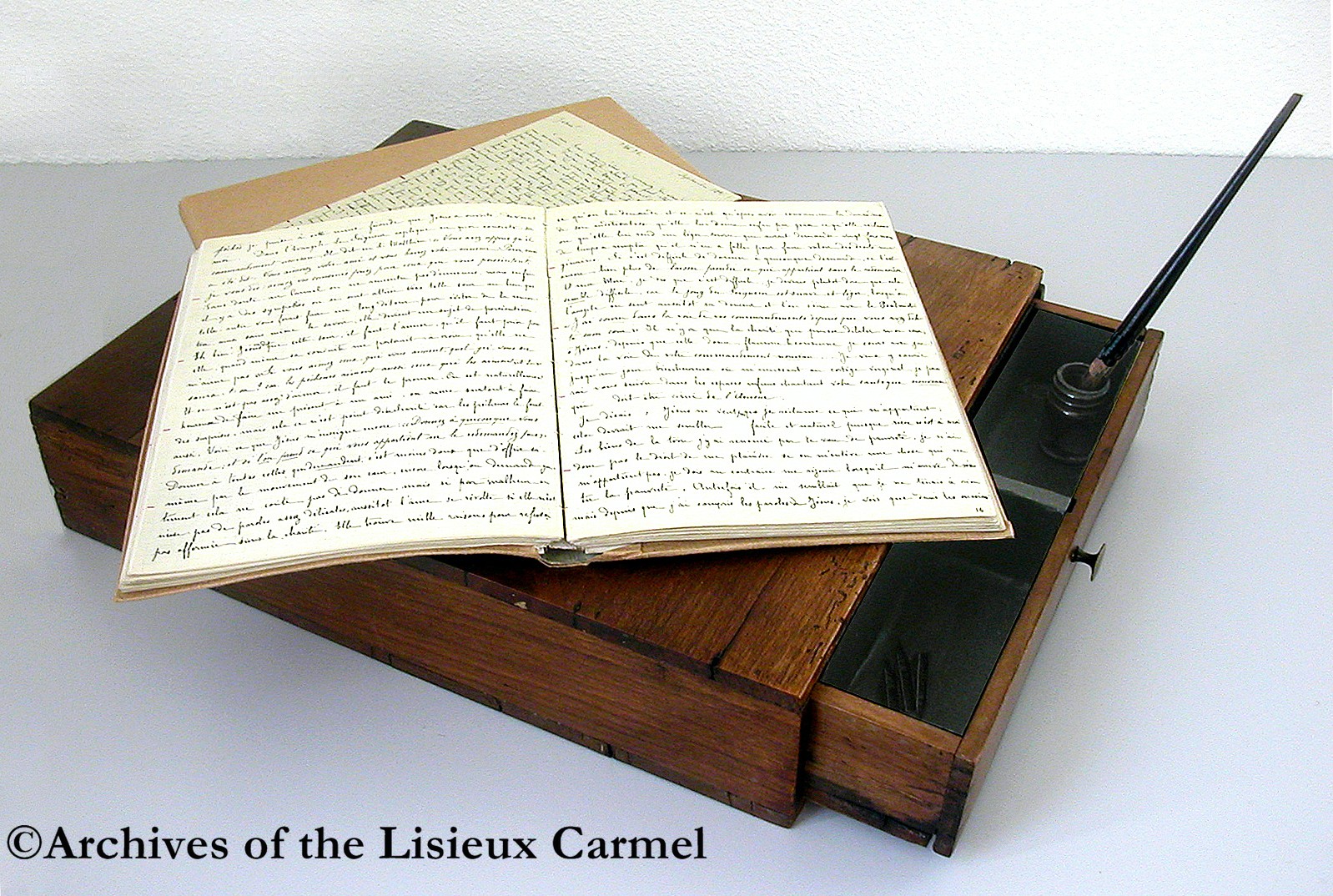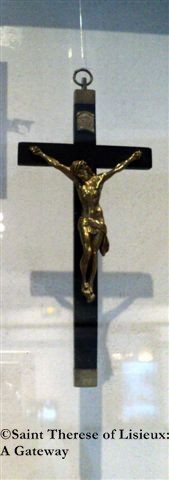Saint Therese of the Child Jesus
of the Holy Face
Photos of the visit of the writing-desk of St. Therese of Lisieux to San Rafael Church in San Diego, August 30, 2013
See an album of photos of the visit of the writing-desk of St. Therese of Lisieux to San Rafael Church in San Diego, California on August 30, 2013.
The writing-desk of St. Therese of Lisieux to be venerated by a thousand people in Orange County, California

The diocese of Orange, California has announced that the writing-desk on which St. Therese of Lisieux wrote Story of a Soul will be present at the eighth annual Orange County Prayer Breakfast on September 18 at Christ Cathedral, where more than a thousand people are expected. The morning will include a procession and veneration of the writing-desk, which St. Therese used to write the manuscripts that, published in book form, have touched so many souls. The writing-desk will be in the diocese of Orange as part of a national tour sponsored by the Pontifical Mission Societies of the United States.
"We are blessed to have the relics of St. Thérèse of Lisieux present at this year’s celebration. The life of St. Thérèse offers a lesson for each of us, baptized into the continuing mission of Jesus,” said Bishop Vann.
I hope very much that all the people who come to pray in the presence of the writing-desk will also read or re-read the memoir that made the desk famous:
In a sense, Therese comes to us on pilgrimage with this artefact. She, who said "I really count on not remaining inactive in heaven; my desire is to work still for the Church and for souls," does not wait for us to come to France. Instead, through the grace of God, her spirit is poured out on the prayerful gatherings where the little, old writing-case she used is venerated. Her pilgrimage will be complete only when her writings accompany the pilgrims home, and, as we read her story, she can write to each of us the words she wrote to her sister at the beginning of her first manuscript: "It is to you that I come to confide the story of my soul. . . . I shall begin to sing what I must sing eternally: the Mercies of the Lord!"
If you cannot come to see the writing-desk (see the tour schedule), please read Story of a Soul, the book hat made it famous. If you plan to come to see it, read the book or Therese's other writings before you come. Or, if you pray in the presence of the desk before you've read Therese's writings, read them afterward. She has enabled countless people to read their own lives in the light of her story and to see how God's mercy overwhelms us, as it did her.
The writing-desk on which St. Therese of Lisieux wrote "Story of a Soul" will visit St. James Cathedral in Seattle on September 14, 2013 and St. Cecilia's Church in Stanwood, Washington on September 15
The religious profession of St. Therese of Lisieux, September 8, 1890
Seotember 8, 1890, the feast of the Nativity of Mary, was the date set for St. Therese's religious profession. At that time nuns did not make temporary vows, so one's novitiate ended with the one set of permanent vows. According to the custom of Carmel, professions were usually made on a feast day of Mary, the patron of the Carmelite Order. Therese wrote "Mary's nativity! What a beautiful feast on which to become the spouse of Jesus!"1
On every September 8, the Carmelites of Lisieux exposed on the altar of the choir a small wax statuette representing the newborn Mary so that the nuns could venerate it there. The statue was called "La Bambina." Please click here to see the statue and here to see a close-up of the face of the statue. Have you ever seen another statue representing the infant Mary?
We may imagine Therese and her sisters venerating this statue on Therese's Profession day, the feast of the Nativity of Mary every year.
For Therese's dispositions in the days leading up to her Profession, please see the letters St. Therese wrote during her retreat for Profession, starting here.
On the morning of September 8, 1890, after Mass, the community escorted Therese, in procession, to the chapter room on the second floor, where the ceremony of professing vows was always held. This ceremony was a private one for Therese's Carmelite family. Click here to see a photograph of the chapter room decorated for a Profession. The young nun prostrated herself on the carpet for part of the ceremony. Over her heart Therese wore her "profession note," a little letter to Jesus expressing her desires. Please see both the English typescript and the handwritten note in French. During the ceremony the prioress placed on her head this crown of white roses:

This particular crown of roses had been worn by Mother Genevieve, a foundress of the Lisieux Carmel, for her jubilee, and Therese's sisters Pauline, Mother Agnes of Jesus, and Marie, Sister Marie of the Sacred Heart, also wore it for their professions. A few days before Therese's profession it was entrusted to Celine, who brought it to her father at the Bon Saveur mental hospital in Caen so that he might bless it.
During the ceremony Therese received her Profession crucifix from the prioress:

From Therese's own writings we know that she was "obliged" to ask for her father's cure that day, but would only pray "My God, I beg You, let it be Your will that Papa be cured." Much bolder was her prayer for Leonie: "Let Leonie become a Visitation nun, and, if she has no vocation, I beseech You to give her one; You cannot refuse me that." For how Therese remembered her profession later, see both the English typescript and the French handwritten manuscript of Therese's description of her Profession in her memoir, Story of a Soul.
For the two photos displayed here, I thank Adele Giambrone. For the linked photos, I thank the Web site of the archives of the Carmel of Lisieux. For the text, I thank the Washington Province of Discalced Carmelites, which owns the English text, and the Web site of the archives of the Carmel of Lisieux, which dislayed it online. Special thanks to the Internet Archive.
[Note that the new Web site of the Archives of the Carmel no longer displays the above-referenced translation].
1. Story of a Soul: The Autobiography of St. Therese of Lisieux, tr. John Clarke, O.C.D., Third Edition. Washington, D.C.: ICS Publications, 1996, p. 167.
Pope Francis to use excerpts from St. Therese's poem "Why I Love You, O Mary" in the prayer vigil for peace September 7
The Vatican has published in Italian a worship aid for the Vigil of Prayer for Peace that is going to be conducted in Rome on September 7, 2013. The vigil will include the five joyful mysteries of the rosary, and, after each decade, the stanza of St. Therese's poem "Why I Love You, O Mary" that corresponds to that mystery will be read. See Deborah Thurston's English translation of the vigil worship aid at her blog, Karmalight. You may download the Italian booklet here. Be aware the download may be slow.
Therese wrote "Why I Love You, O Mary," her last poem, in May 1897. It is a long meditation on Mary in the gospels: Mary's humble, hidden, ordinary life; Mary's union with Jesus; Mary, our mother. It is impossible to exhaust the poem's riches here. Please read the twenty-five verses and see the handwritten manuscript of "Why I Love You, O Mary" here.
To explore the riches of all Therese's poetry, please see The Poetry of Saint Therese of Lisieux, translated by Donald Kinney, O.C.D. Washington, D.C.: Washington Province of Discalced Carmelite Fathers, 1995. The introductions and notes to each poem are invaluable in setting each poem in the context of Therese's life and community.
One of Therese's most extraordinary assertions is "Mary, you love us as Jesus loves us." May we place our prayer for peace in the hands of St. Therese and in the hands of Mary, and may they obtain for us the gift of peace in the world.


